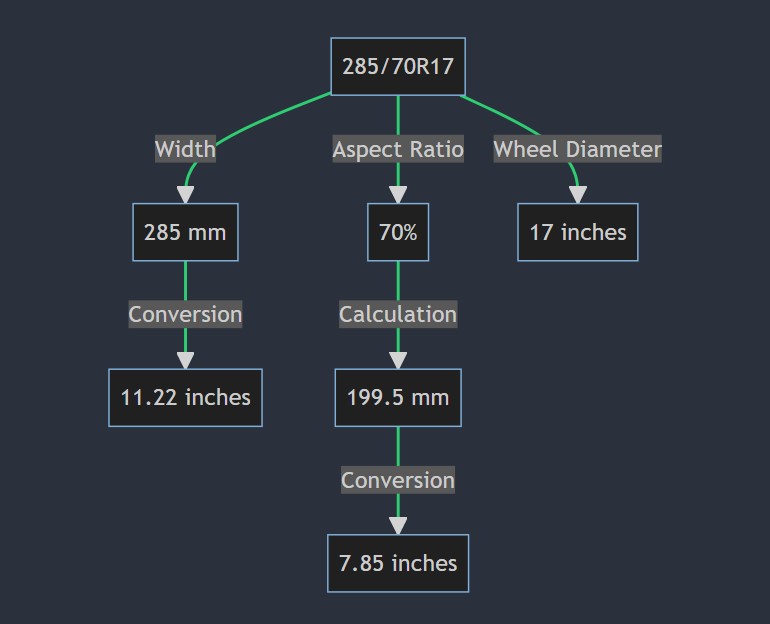The 285/70R17 tire has an overall diameter of approximately 32.7 inches, a section width of roughly 11.2 inches, and is designed to be mounted on a 17-inch diameter rim. The equivalent tire size in the high flotation system is 32.7×11.2R17.

What Does 285/70r17 Tire Mean?
Let’s not beat around the bush. To the untrained eye, 285/70r17 looks like something straight out of a high school algebra book. But the good news is, it’s a lot simpler than it seems! To help you understand, let’s break it down into a table:
| Tire Number | Its Explanation |
| 285 | This is the tire’s width in millimeters from sidewall to sidewall. So, this tire is 285mm wide. |
| 70 | This is the aspect ratio. It’s a percentage representing the height of the tire’s cross-section to its width. In this case, the height of this tire is 70% of its width. |
| R | The ‘R’ stands for Radial, which is the type of tire construction. Almost all modern tires are Radial tires. |
| 17 | This last number represents the wheel diameter in inches. So, this tire is designed to fit on a 17-inch wheel. |
Already feel like a tire whiz? Excellent! We’re just getting warmed up. Now let’s translate those metrics into a language that’s universally understood – inches.
285/70r17 Tire in Inches
Alright, strap in, we’re going to do some math now. Don’t worry, I promise it won’t be as painful as your high school calculus class!
First, we need to convert the width from millimeters to inches. There are approximately 25.4 millimeters in one inch. So, to convert our 285mm width, we divide 285 by 25.4, which equals about 11.22 inches.
The sidewall height is calculated as a percentage of the tire’s width, remember? So, we take 70% of 285mm, which gives us 199.5mm. Let’s convert that to inches as well, and we get about 7.85 inches.
And finally, the wheel diameter is already conveniently given in inches (17 inches), so no conversion is needed there.
Phew! The math is over. Promise.
In summary, a 285/70r17 tire is approximately 11.22 inches wide, with a sidewall height of about 7.85 inches, and fits a 17-inch wheel.
| Measurement | Inches | Millimeters |
| Tire Diameter | 33.71 | 856 |
| Section Width | 11.22 | 285 |
| Rim Height | 17 | 431.8 |
| Sidewall Height | 7.85 | 199.5 |
| Circumference | 105.78 | 2686.7 |
| Revolutions | 598 per mile | 371 per kilometer |
Tire Width of 285/70r17
The “285” in 285/70r17 refers to the tire’s width from one sidewall to the other, measured in millimeters. To convert this into inches, we divide by 25.4 (since there are 25.4mm in an inch). This gives us a tire width of approximately 11.22 inches.
Tire Height of 285/70r17
Also known as the tire’s diameter, this can be calculated using the width and aspect ratio. We’ve already established the width of the tire as 285mm, and the aspect ratio (the ’70’ in 285/70r17) is the height of the tire’s cross-section as a percentage of the width. So, 70% of 285mm gives us the sidewall height, and adding the diameter of the rim (in mm, twice, since there is sidewall on both top and bottom) will give the total tire height. This is about 33.71 inches.
Sidewall Height of 285/70r17
The sidewall height can be calculated using the tire width and the aspect ratio. In this case, the tire’s aspect ratio is 70%, which means the height is 70% of the tire’s width. So, 70% of 285mm is 199.5mm. Converting that to inches gives a sidewall height of approximately 7.85 inches.
Rim Diameter for 285/70r17
The “17” in 285/70r17 stands for the rim diameter and is measured in inches. So, this tire will fit a rim that is 17 inches in diameter.
Tire Circumference of 285/70r17
The tire circumference can be calculated using the tire’s diameter (D). The formula for calculating the circumference (C) of a circle is C = πD. Using the calculated diameter of approximately 33.71 inches, the tire’s circumference is about 105.78 inches.
Please note, these are all approximate measurements, as different manufacturers may have slightly varying sizes even for tires marked with the same size code. Always consult with your tire manufacturer or a professional for exact measurements for your specific tire.
Best 265/70r17 Tires
1. Michelin Defender LTX M/S
The Michelin Defender LTX M/S is an all-season tire that combines the proven tread design of the LTX M/S with Evertread compound to provide durable tread life, no matter the season. It’s ideal for drivers of pickups, crossovers, and sport utility vehicles.
Pros:
- Excellent all-weather performance, making it versatile across seasons.
- The Evertread technology provides longer wear life in severe conditions.
- Superior comfort and quietness on the road.
Cons:
- It may not perform as well in heavy off-road conditions compared to dedicated off-road tires.
- The price point may be on the higher end for some consumers.
Final Recommendation:
For drivers seeking an all-round performer, the Michelin Defender LTX M/S is a top pick. With superior longevity, comfort, and all-season reliability, it offers an excellent balance for those who value durability and all-weather performance. It may cost a little more, but as the saying goes, “You get what you pay for.”
2. BF Goodrich All-Terrain T/A KO2
The BF Goodrich All-Terrain T/A KO2 is a tire designed to deliver go-anywhere traction along with outstanding durability and longevity. This all-terrain tire is an excellent choice for drivers of jeeps, pickup trucks, and SUVs who enjoy venturing off the beaten path.
Pros:
- It boasts excellent traction on all types of terrains, including mud, rocks, and snow.
- Reinforced sidewalls resist punctures and cuts for off-road adventures.
- Impressive tread life for an all-terrain tire.
Cons:
- May generate more road noise compared to all-season tires.
- In icy conditions, performance might not be as excellent as in mud or gravel.
Final Recommendation:
If you’re the adventurous type who doesn’t want to be limited by where the road leads, the BF Goodrich All-Terrain T/A KO2 is for you. With its strong off-road capabilities and durability, it won’t let you down when the going gets tough.
3. Goodyear Wrangler Duratrac
Goodyear Wrangler Duratrac is an aggressive all-terrain tire designed for pickup trucks, vans, and SUVs in both on and off-road conditions. With its TractiveGroove Technology, it provides enhanced traction in deep mud and snow.
Pros:
- Excellent off-road traction in various conditions.
- Self-cleaning shoulder blocks clear the tread of debris for enhanced dirt, gravel, and mud traction.
- Despite being aggressive, it provides a decently quiet ride on highways.
Cons:
- Might not wear as evenly or last as long as some other models.
- While quiet for an all-terrain tire, it’s louder than a standard road tire.
Final Recommendation:
For drivers who want a combination of aggressive off-road performance and quiet, smooth on-road driving, the Goodyear Wrangler Duratrac is a fantastic choice. It might not be the longest-lasting tire on the market, but for versatility and strong performance in diverse conditions, it’s hard to beat.
FAQ’s
What Vehicles Use a 285/70r17 Tire?
The 285/70r17 tire size is commonly used on light trucks, SUVs, and some larger crossovers. Some specific models that often use this tire size include but are not limited to:
- Certain versions of the Chevrolet Silverado
- Some models of the Dodge Ram
- Nissan Titan
- Ford F-150
- Toyota Tacoma and Tundra
- Jeep Wrangler
Remember, tire size can vary even within the same vehicle model, so always check your vehicle’s manual or consult with a tire professional to ensure you choose the correct size.
How Many Revolutions per Mile Does a 285/70r17 Have?
The number of revolutions per mile for a tire can be determined by the tire’s overall diameter. For a 285/70r17 tire, the estimated diameter is about 33.71 inches. With this diameter, the tire would make approximately 598 revolutions per mile. However, this is an estimate, and the actual number may vary slightly based on the specific design of the tire.
What is the Price of a 285/70r17 Inch Tire?
The price of a 285/70r17 tire can vary significantly depending on the brand, type (all-season, winter, all-terrain, etc.), and where you’re purchasing from. On average, as of my last update in September 2021, you can expect to pay anywhere from $150 to $300 per tire. Some premium models or specialty tires might cost more. Remember that this is a rough estimate and prices can change based on location, dealer, and even time of year. Always shop around to ensure you’re getting the best deal.
What Kind of Rim Does a 285/70r17 Tire Fit On?
The “17” in 285/70R17 denotes the diameter of the rim that the tire is designed to fit on, measured in inches. Therefore, this tire size is intended for a 17-inch diameter rim. However, the width of the rim also matters. Typically, for a 285/70R17 tire, the recommended rim width is between 7.5 to 9 inches. Always consult the tire manufacturer’s recommendations for optimal performance and safety.
How Much Air Should Be in a 285/70r17 Tire?
The ideal tire pressure can vary based on the vehicle, tire brand, and the vehicle’s load. As a general guideline, many light truck tires in this size range will recommend a pressure between 30 to 35 PSI (pounds per square inch) when the tires are cold. However, for the exact pressure, refer to the vehicle’s owner’s manual or the tire information placard often located on the driver’s door jamb or in the glove box.
What is a 285/70r17 Equivalent To?
Tire sizes can sometimes be represented in different ways. A 285/70R17 tire is a metric tire size, and it can also be expressed in a flotation tire size format. The flotation equivalent would be approximately a 33×11.50R17. This means the tire is 33 inches in diameter, 11.50 inches in width, and fits on a 17-inch diameter rim. However, tire sizes are not perfectly interchangeable and there can be slight differences in their dimensions. Always ensure the alternate tire size is approved for your specific vehicle and rim.
Comparison with Similar Tires
265/70r17 vs 285/70r17
The main difference here is the width of the tire. The 285/70r17 is wider by 20mm compared to the 265/70r17. This means it could provide a bit more traction, but it might also affect fuel economy slightly due to the larger contact area with the road.
285/70r17 vs 285/75r17
The primary difference here is the aspect ratio, which is the height of the tire’s sidewall as a percentage of its width. The 285/75r17 has a higher sidewall, making the tire taller overall. This can result in better off-road performance but might affect handling on roads.
275/70r17 vs 285/70r17
The primary difference between these two tire sizes is width. The 285/70r17 tire is 10mm wider than the 275/70r17, providing potentially better traction but possibly affecting fuel efficiency.
285/70r17 vs 295/70r17
Again, the difference here is in width. The 295/70r17 tire is 10mm wider than the 285/70r17. This slight increase in width could result in better traction, but it might also have an impact on fuel economy.
255/75r17 vs 285/70r17
Here, the 285/70r17 is wider and has a smaller aspect ratio, meaning it’s wider and slightly shorter than the 255/75r17. The wider tire may offer better traction, while the shorter one might provide better fuel economy.
245/75r17 vs 285/70r17
The 285/70r17 tire is significantly wider and has a slightly smaller aspect ratio than the 245/75r17. This means it’s wider and shorter, which could affect handling, traction, and fuel economy.
285/70r17 vs 315/70r17
The 315/70r17 is significantly wider and slightly taller than the 285/70r17. The wider and taller tire may provide better off-road performance but may negatively impact fuel economy and handling on the road.
265/70r17 vs 285/75r17
The 285/75r17 tire is wider and has a larger aspect ratio than the 265/70r17, meaning it’s wider and taller. The wider, taller tire may offer better off-road performance but could negatively impact fuel economy.
295/70r17 vs 285/75r17
The 285/75r17 is slightly less wide but has a higher aspect ratio than the 295/70r17, meaning it’s a bit narrower and taller. This could affect off-road performance, handling, and fuel economy in different ways.
Conclusion
In essence, the difference between these various tire sizes largely comes down to the width and height of the tire. Depending on the specific characteristics of your vehicle, driving habits, and the conditions in which you typically drive, different tire sizes may offer certain advantages.
Always keep in mind that any changes to your vehicle’s tire size should be made with caution. Even small changes can have significant impacts on vehicle performance and safety. Always consult with a tire or automotive professional before deviating from the tire size recommended by your vehicle’s manufacturer. After all, as much as we may love the thought of sporting monstrous tires on our vehicle, safety and performance should always take the wheel!

AR Jeet has been a tire mechanic for over 2years. He has worked on all types of vehicles, from cars and trucks to RVs and ATVs and motorcycles. He has seen it all when it comes to tires, and he knows how to fix them.
AR Jeet is a tire expert, and he is passionate about his work. He loves to help people keep their vehicles running smoothly, and he is always happy to answer any questions that people have about their tires.
If you need help with your tires, or if you just want to learn more about them, then AR Jeet is the man to talk to. He will be happy to help you out, and he will make sure that you get the best possible solution.
He has a blog [Tirespick.com] where he writes about all things tire-related, and he is always happy to help people with their tire needs. Know more about AR Jeet.
